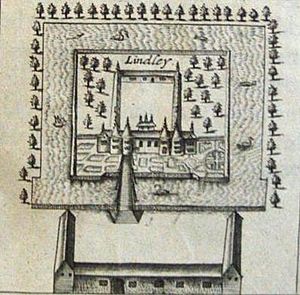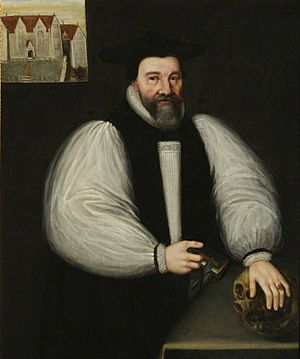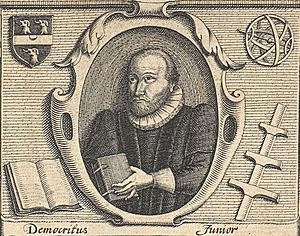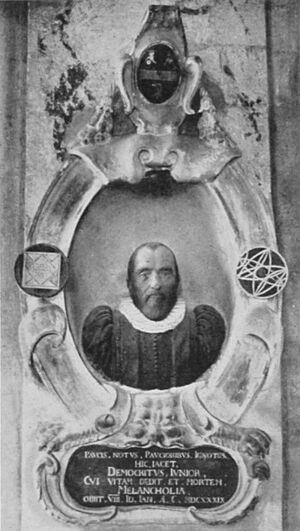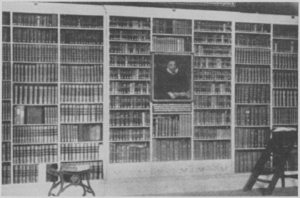Robert Burton facts for kids
Robert Burton (born February 8, 1577 – died January 25, 1640) was an English writer and a member of Oxford University. He is famous for writing a very large book called The Anatomy of Melancholy.
Burton was born in 1577 into a wealthy family. He went to two grammar schools. At age 15, in 1593, he started studying at Brasenose College, Oxford. His time at Oxford was unusually long. This might have been because he suffered from melancholy, a type of sadness. He later moved to Christ Church.
Burton earned two degrees, an MA and a BD. By 1607, he was qualified to be a tutor. He started writing early in his life at Oxford. He wrote some Latin poems and a play that is now lost. This play was performed for King James I, who did not like it. His only surviving play is an academic comedy called Philosophaster.
After getting his MA in 1605, Burton tried to leave the university. He never fully left, but he did get some church jobs. He became the vicar of St Thomas the Martyr's Church, Oxford through the university. He also got jobs in Walesby and Seagrave with help from others.
As a member of Oxford, he had many small jobs. He was also the librarian of Christ Church Library from 1624 until he died. Over time, he grew to like his quiet life in the Oxford libraries. He often spoke highly of his university in his book, The Anatomy.
Burton's most famous work was The Anatomy of Melancholy. It was first published in 1621. He added to it and reprinted it five more times during his life. This book was very long and jumped between many topics. Burton wrote it to help himself with his own melancholy, and to help others too. The final version had over 500,000 words. The book is full of quotes from many old and new writers. It showed how much he had learned over his lifetime.
Burton died in 1640. His large personal library was split between the Bodleian Library and Christ Church. Many writers read and copied from The Anatomy during his life and after his death. Its popularity decreased in the 1700s. However, interest in his work grew again in the 1800s. This happened when people found out that Laurence Sterne had copied parts of it. Famous readers of Burton's book include Samuel Johnson, Benjamin Franklin, and John Keats.
Contents
Robert Burton's Early Life and School
His Family and First Schools
Robert Burton was born on February 8, 1577. His parents were Ralph and Dorothy Burton. He was born in Lindley, Leicestershire, England. Robert was the second of four sons and the fourth of ten children. His older brother, William, became a well-known historian.
Both of Robert's parents came from wealthy families. Robert may have gotten his interest in medicine from his family. In his book, he wrote that his mother was very skilled in "chirurgery," which means surgery. His brother William said that a relative, Anthony Faunt, died from "melancholy."
Burton likely went to two grammar schools. These were the King Edward VI Grammar School and Bishop Vesey's Grammar School. In his book, Burton wrote that students thought school was like "slavery." Some people think this means he was unhappy at school. But others believe he was just stating a common idea, not sharing his own feelings.
His Education at Oxford University
In July 1593, when he was 15, Burton started at Brasenose College in Oxford. His older brother was already studying there. Burton did not get his first degree until June 30, 1602. This was after he moved to Christ Church College in 1599. We know very little about Burton's time at Brasenose.
Most Oxford students finished their studies by age 19. But Burton was 26 when he got his first degree. Some writers think this means he had a long illness, possibly melancholy. Records show a "Robart Burton of 20 yeres" was treated for melancholy in 1597. This person might have been the scholar Robert Burton.
When he joined Christ Church in 1599, John Bancroft became his tutor. Bancroft was only three years older but much further along in his studies. He was also well-connected in the church. He later became the Bishop of Oxford. It seems they became friends. Burton praised Bancroft's building at Cuddesdon in his book. This suggests he visited his old tutor often.
At Christ Church, Burton earned his MA degree in 1605 and a BD degree in 1614. He also moved up in the college. By 1607, he was qualified to be a tutor. After getting his MA, Burton probably tried to leave the university.
His Early Writings and Plays
While at Oxford, Burton also pursued his interest in writing. In 1603, when James I became king, Burton wrote a short Latin poem to celebrate. He wrote 21 more poems when James visited Oxford in 1605. During this visit, Burton helped prepare for the king's arrival. He even wrote a play for the occasion.
This play, called Alba, was a comedy in Latin. It was performed for King James I on August 27, 1605. But the king and his court did not like it. The king was so unhappy that he almost left before the play was half over.
Despite this, Burton was already working on another play by 1606. This play, Philosophaster, still exists today. He finished it by 1615 and kept revising it. Burton mentioned Philosophaster in his book. He said it was performed at Christ Church on February 16, 1617. Students and three local townsmen acted in the play.
Robert Burton's Jobs and The Anatomy of Melancholy
Church Jobs in Oxford, Walesby, and Seagrave
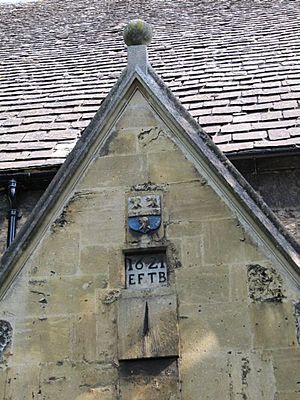
At first, Burton found it hard to get jobs outside the university. But after some time, he got a church job at St Thomas the Martyr's Church, Oxford. This church was in the western part of Oxford. He was chosen for this job on November 29, 1616. He was allowed to preach there starting December 3, 1618.
Burton stayed at St Thomas's until he died. He was in charge of building or rebuilding the church's south porch in 1621. His family symbol was placed on the porch.
In 1624, Lady Frances Cecil gave Burton a job in Walesby, Lincolnshire. Burton probably tutored her son, Robert Smith. Burton chose not to live in Walesby, but he likely visited. He did not get involved in the daily church matters there. However, he did win nine acres of land for the church that had been taken by the previous owner. Burton left this job in 1631.
In 1632, soon after leaving Walesby, Burton got a much better job. His supporter, Lord Berkeley, gave him the job of rector of Seagrave. Lord Berkeley had supported Burton since at least 1621. Burton had dedicated his book, The Anatomy, to Lord Berkeley.
On June 15, 1632, Burton officially got the job at Seagrave. This was the most valuable job Burton ever had. In 1650, it was worth £100. Burton did not publish any sermons from his time at Seagrave. But he did his duties well and on time. He likely visited his family home in Lindley often, as it was only 20 miles away.
Life at Oxford University
Burton did not get many other important jobs. Because of this, he stayed at Oxford University for the rest of his life. At first, he seemed unhappy about this. In the 1621 edition of his book, he wrote that his "hopes were still frustrate." He felt "confined to my Colledge."
But by the final edition of his book, he had changed his mind. He praised his "monastick life" and being "sequestered from those tumults & troubles of the world." He called Oxford "the most flourishing College of Europe." The Bodleian Library at Oxford reopened in 1602. By 1620, it had over 16,000 books. This made Oxford a great place for scholars.
Burton did not spend all his time just studying. He held several small jobs at Oxford. Three times, in 1615, 1617, and 1618, he was chosen as the clerk of the Market. This job involved regulating goods in Oxford's markets. This shows that Burton knew about the daily life of Oxford, not just books.
On August 27, 1624, Burton became the librarian of Christ Church Library. This was a new job, created only about 50 years earlier. A recent donation had made the librarian's pay much better. The duties were light, mostly opening and closing the library. This probably gave Burton plenty of time to read and learn. He held this job until he died. In 1635, a painter named Gilbert Jackson painted a portrait of Burton.
Publishing The Anatomy of Melancholy
| Information about Burton's Anatomy. | ||||
|---|---|---|---|---|
| Date | Edition | Binding | Location | Words |
| 1621 | 1st | 4to | Oxford | 353,369 |
| 1624 | 2nd | fo | Oxford | 423,983 |
| 1628 | 3rd | fo | Oxford | 476,855 |
| 1632 | 4th | fo | Oxford | 505,592 |
| 1638 | 5th | fo | Oxford | 514,116 |
| 1651 | 6th | fo | Oxford | 516,384 |
| 1660 | 7th | fo | London | 516,384 |
| 1676 | 8th | fo | London | 516,384 |
Writing The Anatomy was the most important thing Burton did in his life. He said he was "fatally driven" to write about melancholy. He did not leave a record of when he started the book. But he had finished it by December 5, 1620, when he was 43.
The book was printed in 1621. It sold very well. The publisher, Henry Cripps, made a "great profit" from it. Other books on melancholy had also been popular. Burton used the pen name "Democritus Junior." This name referred to an ancient Greek philosopher known as "the Laughing Philosopher." Using a famous name was common then. It helped readers have a good first impression of the author.
Burton kept editing and improving the book throughout his life. The first edition had over 350,000 words. By his final edition, it had over 500,000 words. The biggest additions were for the second and third editions. The book had to be made larger to fit all the new text. For the third edition (1628), a picture was added to the front. It showed Burton with his pen name, Democritus Junior.
After these additions, Burton said he would not add or change anything more. But he did. He produced two more editions in 1634 and 1638. Before he died in 1640, he gave a special copy of the book to his publisher. This copy was published after his death in 1651. In total, Burton helped with six editions of the book. Two more reprints were made before the end of the 1600s.
Robert Burton's Death
Burton wrote his will on August 15, 1639. Five months later, on January 25, 1640, he died at age 62. In his will, he left his inherited property to his older brother, William, and William's children. He also left money to the Bodleian and Christ Church libraries. He gave them £100 each. His large library was split between these two places.
He also left smaller amounts of money to his servants. He gave money to the poor in Seagrave, Nuneaton, and Higham. He also left money to the Brasenose library and to various friends. Burton was buried in Christ Church Cathedral on January 27. William built a monument for Robert in the cathedral. It has a colored statue of Robert and a short Latin message that Robert is said to have written himself.
The Anatomy of Melancholy
The Anatomy of Melancholy is Robert Burton's most important work. It is a three-part book about depression and how to treat it. The book is filled with quotes, summaries, and comments from many writers. These writers came from different fields and lived from ancient times to Burton's own time.
The book's structure is complex and jumps around a lot. Burton himself admitted it was a "confused lump." He said he did not have enough time to organize it better. He added more to the book over time, but he did not make it less confusing. The book shows how much Burton had learned. However, Burton also wrote that too much learning is pointless. He even suggested it might be better to remain unaware.
Burton wrote The Anatomy of Melancholy mainly to help himself. He suffered from depression his whole life. In his introduction, he said he had "a kind of imposthume in my head." He felt he needed to get rid of it. He believed writing was the best way to do this. He wrote, "I write of melancholy, by being busy to avoid melancholy." He thought that being idle was a big cause of melancholy. He also believed that being busy was the best cure.
Burton saw melancholy as a very common "disease." He said that "few there are that feele not the smart of it." He wrote his book to find ways to prevent and cure this "universal sickness." For Burton, "melancholy" included many mental problems. These ranged from being overly focused on something to having false beliefs, or what we now call clinical depression. Burton offered many cures for melancholy. But he also said they were all useless, which was typical of his contradictory style.
Philosophaster
Philosophaster is a play written in Latin. Burton wrote it when he was a student at Oxford. It makes fun of universities in the 1600s. The play is about a university in Spain that was founded to attract smart people. But instead, it attracts "philosophasters," who are fake philosophers. They trick the Duke and the townspeople.
In the play, two true philosophers appear. Their names mean "Much-Learned" and "Lover of Books." They expose the fake philosophers. In the funny ending, the fraudsters are punished and sent away. The play finishes with a song praising philosophy.
Robert Burton's Personal Life
His Character
Some writers from the Romantic period later said Burton was a loner. But there is "no evidence that Burton was a recluse." He was active in Oxford's daily life. He had jobs in the church and market. He was also known as a mathematician, astrologer, and astronomer. He was even known as a surveyor.
Burton was very good at using quotes from poets and classical writers in his everyday speech. This was popular at the university and made him well-liked. However, his main activities were reading and writing. His very large library shows how much he loved books.
His Religious Views
Some people think Burton's family had some Catholic leanings. This is because they were related to a Jesuit named Arthur Faunt. Burton's brother, William, admired Faunt. William also supported certain church reforms that were sometimes seen as leaning towards Catholicism. At St Thomas's, Burton was one of the last priests to use unleavened wafers in Communion. This was an old practice.
However, as an Oxford scholar, Burton might not have liked Archbishop Laud. Laud was in charge of Oxford from 1630 to 1641. He often argued with the scholars, which Burton would not have liked. Burton also seemed to support King James I's rules against Catholics. He took an oath of loyalty to the king. The anti-Catholic parts of his play Philosophaster were changed after the king released this oath.
Burton also said he did not want to become a Doctor of Divinity. This was partly because he did not want to get involved in endless religious arguments. He felt there was "no such great neede" for them.
His Library
To say Burton was "bookish" is an understatement. He owned 1738 books in total. This was ten times more than a typical Oxford scholar. He collected these books over 46 years, from 1594 to 1640. The money he made from The Anatomy probably paid for most of his library. His regular jobs would not have been enough.
Most of his books were in Latin. But he also had an unusually large number of English books. He seemed uncomfortable reading in other languages. He had only a few books in Italian, German, Spanish, and Hebrew. He had no books in Greek, even though he often mentioned Greek ideas in his book.
Most of Burton's library was made up of newer books. He owned hundreds of cheap pamphlets, comedies, and popular plays. These types of works were not usually collected by the newly founded Bodleian Library. This might be why Burton bought them. Religious books made up about a quarter of his library. The rest was a mix of literature, history, medicine, and geography. This shows how wide his interests were. Burton loved to write notes in his books. He made notes in about one-fifth of them.
After he died, Burton's library was split between the Bodleian and Christ Church libraries. In the early 1900s, William Osler, a medical professor and fan of Burton, found that Burton's books were scattered. From 1907 to 1908, Osler worked to gather over a thousand of Burton's books into one collection.
At Christ Church Library, Osler set up a display of these books around a copy of Burton's portrait. In 1964, Christ Church Library moved Osler's collection. It now holds 1530 of Burton's 1738 books and two manuscripts. Burton's library is considered "one of the most important surviving English private libraries" from before the English Civil War.
Robert Burton's Fame and Influence
Burton's Anatomy was very popular during his lifetime and throughout the 1600s. It had eight editions from 1621 to 1676. Many writers copied from it. Some writers who lacked ideas would take his many classical quotes. In the 1700s, George Steevens called it "a book once the favourite of the learned."
Scholars copied and used The Anatomy for their own purposes. For example, William Vaughan used Burton's ideas to criticize the court. Nathanael Carpenter copied Burton's personal description of melancholy. Playwrights like John Ford used Burton's book as a guide for showing melancholy in their plays. Richard Holdsworth suggested it as a book for young gentlemen to read for "delight and ornament." The first biography of Burton appeared in 1662.
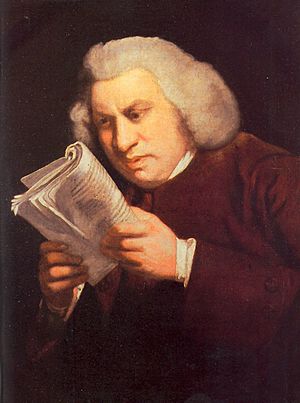
In the 1700s, Burton's popularity decreased. But a few important readers still enjoyed The Anatomy. Samuel Johnson, who also suffered from melancholy, loved Burton's book. His friend Boswell wrote that Johnson said The Anatomy was "the only book that ever took him out of bed two hours sooner than he wished to rise."
Even though no American edition was published until 1836, some famous early Americans read Burton's work. One was Benjamin Franklin. He was amazed that a large book like Burton on Melancholy had six editions in about twenty years. During this time, Burton's influence was mainly as a source of quotes and stories for other writers.
One such writer was Laurence Sterne. He copied parts of Burton's book into his novel Tristram Shandy (1759). This copying was not discovered for almost 30 years. It was revealed in 1798.
After this discovery, interest in Burton and his work grew again. A new edition was published in 1800, the first in over a century. More than 40 editions were published in the 1800s. The Romantics, especially Charles Lamb and Samuel Taylor Coleridge, admired the book. Lamb called Burton "that fantastic great old man." This created the image of Burton as an unusual and very learned academic.
The Anatomy was one of John Keats's favorite books. He used it as a main source for the story of his poem "Lamia" (1820). Not everyone liked Burton's writing style. Some critics in the 1800s found it too academic. The poet T. E. Brown called The Anatomy "the sweepings of the medieval dustbin."

In the early 1900s, the romantic view of Burton changed to a more academic study. William Osler, known as the father of modern medicine, loved Burton's book. He called The Anatomy "the greatest medical treatise written by a layman." Many scholars believe that Osler's influence helped bring new interest to The Anatomy.
Later in the 1900s, some critics looked at The Anatomy as a psychological autobiography. They tried to understand Burton's own mind from his book. However, more recent writers have criticized this approach. They say it confuses Burton's writing style with his real personality.
Burton gained new fans in the 1900s and 2000s. Journalist Nick Lezard noted in 2000 that The Anatomy is still known among "cognoscenti" (people with special knowledge). Samuel Beckett was influenced by Burton's book. He used some of Burton's ideas about women and Latin quotes in his own works.
The famous literary critic Northrop Frye admired The Anatomy. He called it "an enormous survey of human life." He said it was like the works of Chaucer and Dickens, but with books as characters instead of people. Psychiatrist Jacques Barzun called Burton "the first systematic psychiatrist." He praised Burton for collecting many stories of melancholy. He also said Burton treated the mentally ill with "tender sympathy."
American writer Alexander Theroux has named Burton as an influence. English novelist Philip Pullman praised the book in 2005. He called it "glorious and intoxicating." For Pullman, it is "one of the indispensable books." Australian singer Nick Cave also listed Burton's Anatomy as one of his favorite books.
While Burton is mostly known for The Anatomy, his play Philosophaster has also been studied more. It has "received more attention than most of the other surviving examples of university drama." It has been published three more times since the mid-1800s. In 1930, it was even performed at the University of California.
Modern scholars have mixed feelings about the play. Some call it "obvious and elementary." But others describe it as "perhaps the most appealing of Burton's Latin works." They note its "liveliness in its representation of university life." The critic Arthur Henry Bullen said the fake philosophers "are portrayed with considerable humour and skill." He also said the songs in the play were "written with a light hand."
Images for kids
See also
 In Spanish: Robert Burton (escritor) para niños
In Spanish: Robert Burton (escritor) para niños


